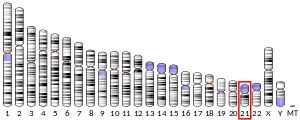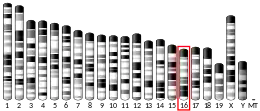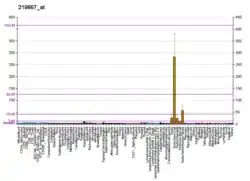CHODL
Chondrolectin is a protein that in humans is encoded by the CHODL gene.[5][6] Mouse chondrolectin is encoded by Chodl.[7]
| CHODL | |||||||||||||||||||||||||||||||||||||||||||||||||||
|---|---|---|---|---|---|---|---|---|---|---|---|---|---|---|---|---|---|---|---|---|---|---|---|---|---|---|---|---|---|---|---|---|---|---|---|---|---|---|---|---|---|---|---|---|---|---|---|---|---|---|---|
| Identifiers | |||||||||||||||||||||||||||||||||||||||||||||||||||
| Aliases | CHODL, C21orf68, MT75, PRED12, chondrolectin | ||||||||||||||||||||||||||||||||||||||||||||||||||
| External IDs | OMIM: 607247 MGI: 2179069 HomoloGene: 11795 GeneCards: CHODL | ||||||||||||||||||||||||||||||||||||||||||||||||||
| |||||||||||||||||||||||||||||||||||||||||||||||||||
| |||||||||||||||||||||||||||||||||||||||||||||||||||
| |||||||||||||||||||||||||||||||||||||||||||||||||||
| |||||||||||||||||||||||||||||||||||||||||||||||||||
| |||||||||||||||||||||||||||||||||||||||||||||||||||
| Wikidata | |||||||||||||||||||||||||||||||||||||||||||||||||||
| |||||||||||||||||||||||||||||||||||||||||||||||||||
Structure
Chondrolectin is a type I membrane protein with a carbohydrate recognition domain characteristic of C-type lectins in its extracellular portion.[5][7] In other proteins, this domain is involved in endocytosis of glycoproteins and exogenous sugar-bearing pathogens.[8] This protein has been shown to localise to the perinucleus.[5][9][10]
Function
The exact function of chondrolectin is unknown but it has been shown to be a marker of fast motor neurons in mice,[10] and is involved in motor neuron development and growth in zebrafish (Danio rerio).[11] Furthermore, human chondrolectin has been shown to localise to motor neurons within the spinal cord.[12]
Clinical significance
Chondrolectin is alternatively spliced in the spinal cord of mouse models[13] of the neuromuscular disease, spinal muscular atrophy (SMA), which predominantly affects lower motor neurons.[12] Increased levels of chondrolectin in a zebrafish model of SMA results in significant improvements in disease-related motor neuron defects.[14]
References
- GRCh38: Ensembl release 89: ENSG00000154645 - Ensembl, May 2017
- GRCm38: Ensembl release 89: ENSMUSG00000022860 - Ensembl, May 2017
- "Human PubMed Reference:". National Center for Biotechnology Information, U.S. National Library of Medicine.
- "Mouse PubMed Reference:". National Center for Biotechnology Information, U.S. National Library of Medicine.
- Weng L, Smits P, Wauters J, Merregaert J (Jun 2002). "Molecular cloning and characterization of human chondrolectin, a novel type I transmembrane protein homologous to C-type lectins". Genomics. 80 (1): 62–70. doi:10.1006/geno.2002.6806. PMID 12079284.
- "Entrez Gene: CHODL chondrolectin".
- Weng L, Hübner R, Claessens A, Smits P, Wauters J, Tylzanowski P, Van Marck E, Merregaert J (Apr 2003). "Isolation and characterization of chondrolectin (Chodl), a novel C-type lectin predominantly expressed in muscle cells". Gene. 308: 21–29. doi:10.1016/s0378-1119(03)00425-6. PMID 12711387.
- Zelensky AN, Gready JE (Dec 2005). "The C-type lectin-like domain superfamily". FEBS J. 272 (24): 6179–6217. doi:10.1111/j.1742-4658.2005.05031.x. PMID 16336259. S2CID 7084402.
- Claessens A, Van de Vijver K, Van Bockstaele DR, Wauters J, Berneman ZN, Van Marck E, Merregaert J (Nov 2007). "Expression and localization of CHODLDeltaE/CHODLfDeltaE, the soluble isoform of chondrolectin". Cell Biol Int. 31 (11): 1323–1330. doi:10.1016/j.cellbi.2007.05.014. PMID 17606388. S2CID 86132649.
- Enjin A, Rabe N, Nakanishi ST, Vallstedt A, Gezelius H, Memic F, Lind M, Hjalt T, Tourtellotte WG, Bruder C, Eichele G, Whelan PJ, Kullander K (Jun 2010). "Identification of novel spinal cholinergic genetic subtypes disclose Chodl and Pitx2 as markers for fast motor neurons and partition cells". J Comp Neurol. 518 (12): 2284–2304. doi:10.1002/cne.22332. PMID 20437528. S2CID 23009923.
- Zhong, Z.; Ohnmacht, J.; Reimer, M. M.; Bach, I.; Becker, T.; Becker, C. G. (2012). "Chondrolectin Mediates Growth Cone Interactions of Motor Axons with an Intermediate Target". Journal of Neuroscience. 32 (13): 4426–4439. doi:10.1523/JNEUROSCI.5179-11.2012. PMC 6622066. PMID 22457492.
- Bäumer D, Lee S, Nicholson G, Davies JL, Parkinson NJ, Murray LM, Gillingwater TH, Ansorge O, Davies KE, Talbot K (Dec 2009). "Alternative splicing events are a late feature of pathology in a mouse model of spinal muscular atrophy". PLOS Genet. 5 (12): e1000773. doi:10.1371/journal.pgen.1000773. PMC 2787017. PMID 20019802.
- Sleigh JN, Gillingwater TH, Talbot K (Aug 2011). "The contribution of mouse models to understanding the pathogenesis of spinal muscular atrophy". Dis. Models Mech. 4 (4): 457–467. doi:10.1242/dmm.007245. PMC 3124050. PMID 21708901.
- Sleigh JN, Barreiro-Iglesias A, Oliver PL, Biba A, Becker T, Davies KE, Becker CG, Talbot K (Sep 2013). "Chondrolectin affects cell survival and neuronal outgrowth in in vitro and in vivo models of spinal muscular atrophy". Hum Mol Genet. 23 (4): 855–69. doi:10.1093/hmg/ddt477. PMID 24067532.
External links
- Human CHODL genome location and CHODL gene details page in the UCSC Genome Browser.
Further reading
- Gerhard DS, Wagner L, Feingold EA, et al. (2004). "The status, quality, and expansion of the NIH full-length cDNA project: the Mammalian Gene Collection (MGC)". Genome Res. 14 (10B): 2121–7. doi:10.1101/gr.2596504. PMC 528928. PMID 15489334.
- Ota T, Suzuki Y, Nishikawa T, et al. (2004). "Complete sequencing and characterization of 21,243 full-length human cDNAs". Nat. Genet. 36 (1): 40–5. doi:10.1038/ng1285. PMID 14702039.
- Clark HF, Gurney AL, Abaya E, et al. (2003). "The secreted protein discovery initiative (SPDI), a large-scale effort to identify novel human secreted and transmembrane proteins: a bioinformatics assessment". Genome Res. 13 (10): 2265–70. doi:10.1101/gr.1293003. PMC 403697. PMID 12975309.
- Weng L, Van Bockstaele DR, Wauters J, et al. (2003). "A novel alternative spliced chondrolectin isoform lacking the transmembrane domain is expressed during T cell maturation". J. Biol. Chem. 278 (21): 19164–70. doi:10.1074/jbc.M300653200. PMID 12621022.
- Strausberg RL, Feingold EA, Grouse LH, et al. (2003). "Generation and initial analysis of more than 15,000 full-length human and mouse cDNA sequences". Proc. Natl. Acad. Sci. U.S.A. 99 (26): 16899–903. Bibcode:2002PNAS...9916899M. doi:10.1073/pnas.242603899. PMC 139241. PMID 12477932.
- Reymond A, Friedli M, Henrichsen CN, et al. (2002). "From PREDs and open reading frames to cDNA isolation: revisiting the human chromosome 21 transcription map". Genomics. 78 (1–2): 46–54. doi:10.1006/geno.2001.6640. PMID 11707072.
- Hattori M, Fujiyama A, Taylor TD, et al. (2000). "The DNA sequence of human chromosome 21". Nature. 405 (6784): 311–9. Bibcode:2000Natur.405..311H. doi:10.1038/35012518. PMID 10830953.




